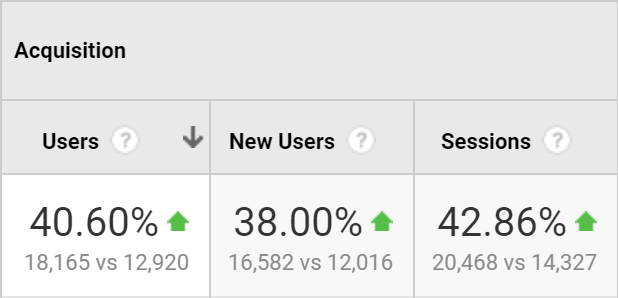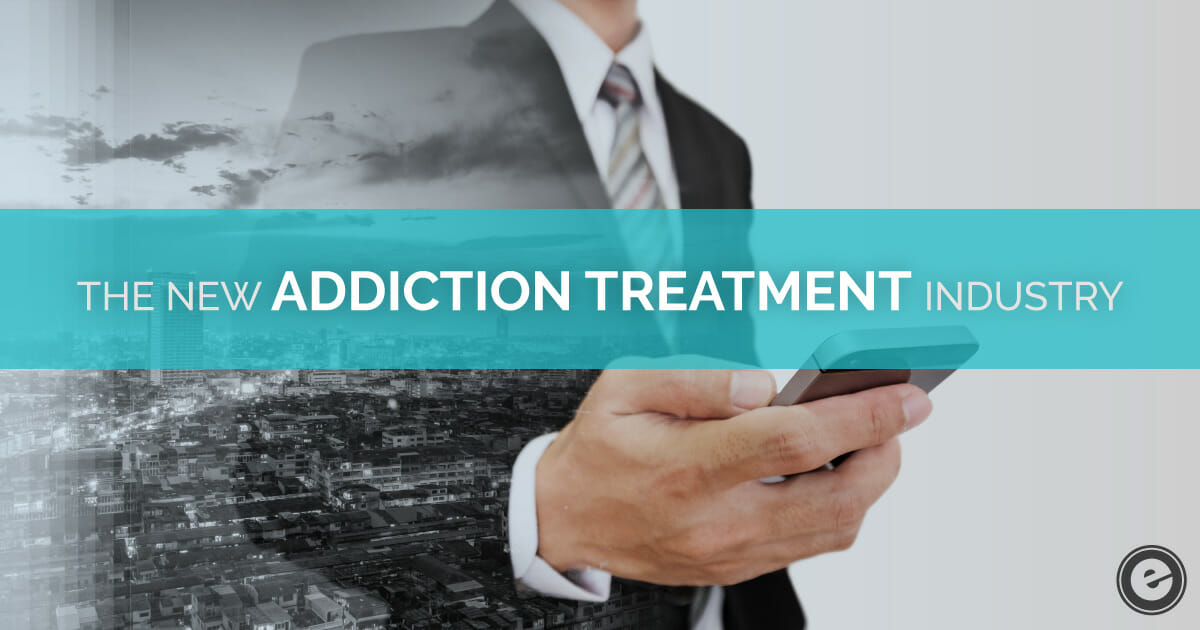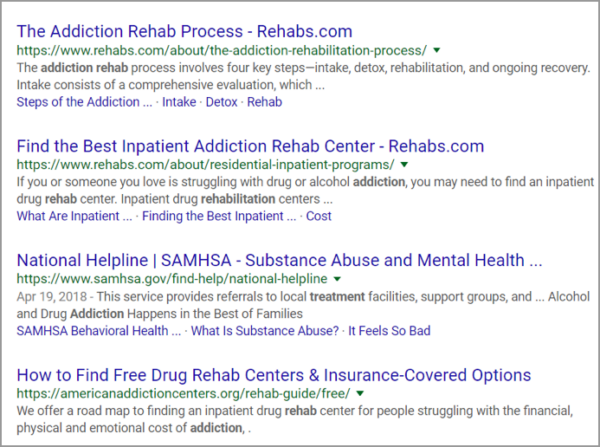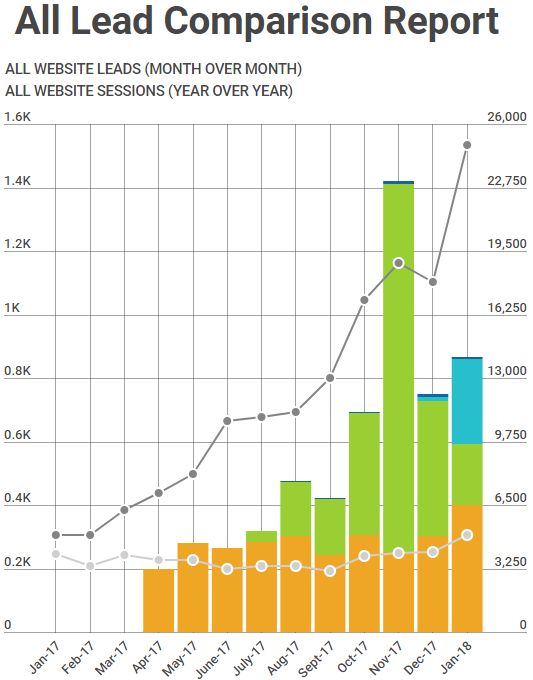We work with several addiction treatment centers, speak with new prospects weekly and work with other consultants, and across the board, we are definitely seeing a trend. Despite increasing demand, treatment centers are finding it harder and harder to get new patients leaving many to wonder, can rehabs survive the big changes to the addiction treatment industry?
Even after growing a new client’s website traffic more than 40 percent month over month…

All Treatment Centers Are Struggling, Even the Big Guys
It’s not just the “ma and pa” centers who are feeling the pain. Big, well-known treatment centers are not paying their employees, closing facilities and filing for bankruptcy.
Elements Behavioral Health, the rehab center that operates the very well-known Promises Malibu that treated actress Lindsay Lohan and singer Britney Spears, filed for filed for chapter 11 bankruptcy protection last month.
In the spring of 2016, Solid Landings didn’t have the resources to keep fighting the city of Costa Mesa, California. So, in a settlement agreement, Solid Landings agreed to shut down 33 sober living homes. Fifteen closed immediately. Just last month, they filed for federal bankruptcy protection.
The FBI raided Sovereign Health last year over patient allegations of insurance fraud. This year, employees are speaking out and even filing claims against the company, saying they are not receiving their paychecks and that no one is being forthright about why.
Why the Addiction Treatment Industry Is Hurting
If you are in the rehab business, you probably saw this video. If not, this might bring some quick clarity:
Despite its intentional focus on poking fun at the treatment space, this video actually hits home in a lot of ways for people familiar with the industry. And… it’s sad.
John Oliver may have not gotten all of the points right, but he touched on many issues that really reveal why the rehab industry is in the state it’s in now. For example:
- Shady practices
- Lack of regulation in the industry
- Insurance fraud
- Misguided ownership
But, that’s not all…
Google has made rehab advertising and marketing harder than ever.
- You can’t really advertise with paid ads anymore – not on any of the keywords that matter, anyway. Read more: Did Google Crush Your Addiction Treatment AdWords Campaign?
- It decided to make SAMHSA No. 1 organically for literally every single addiction treatment-related keyword. Although, just today, we are noticing other sites like Rehabs.com are now coming up in the No. 1 position for some terms again.
- Spammers are still hacking Google Maps and getting away with it. These volunteers fight fake reviews, ghost listings and other scams on Google Maps – and they say the problem is getting worse.
How to Survive Big Changes to the Addiction Treatment Industry
Stay strong, treatment providers. To keep your addiction rehab center afloat during these rough waters, pay closer attention to these five areas:
Evaluate Costs
Knowing how much to spend on operations, overhead and marketing is key to any successful business. However, in the addiction treatment space, there are specific operational pitfalls you can easily avoid by carefully reviewing your internal processes for lead follow-up, staff retention, ground marketing and other non-clinical-related costs.
Align Sales and Marketing Goals
Too many addiction treatment centers rely on the marketing team to provide results. However, marketing is only part of the sales funnel. And if a business expects marketing to perform, the sales team must work hand-in-hand with the marketing team.
Learn more: How to Build an Aligned Sales and Marketing Strategy
Diversify Marketing Efforts
Having been in digital marketing for more than 13 years now, we have seen how unpredictable the internet can be. Because of its volatility, we have always been a strong advocate of multi-channel marketing. What works today can, quite literally, be gone tomorrow, so you should NEVER rely on one source of marketing.
Invest in Branding
So many forms of advertising are built to force the buyer to continue to pay for ads indefinitely. Some platforms wait until you are dependent on their ability to direct clients to you to then jack up the price and force you to pay to get the same leads you once got for a fraction of the price. However, with branding, you are investing in yourself – and this always pays off in big ways long term.
Track Everything
The beautiful part about digital marketing is everything is trackable. The data can tell you where your audience is, what content they engage with, what questions they have, what their likes and dislikes are and so much more.
With the right tracking metrics in place, the data can also tell you which marketing channels are producing leads. And, when the admit team gets involved and provides admission data, we can even report back on which marketing channel produced the admits – and develop strategies that focus on the campaigns that convert the best.
Is the Face of the Addiction Treatment Industry Changing?
With so much bad press, it’s no wonder individuals who are struggling with addiction are hesitant to go into treatment. After watching that John Oliver video, any family member would be right to question the clinical services, price and ethics of any rehab they are evaluating. Who wants to spend tens of thousands of dollars on treatment that might not even work? Tough sale.
The treatment center space is going to have to undergo a complete overhaul – including YOUR brand. You might offer a world-class treatment program, but if you continue to market it as you always have, you may be left in the dust.
The old methods of addiction recovery are already getting replaced by new concepts. Now is the time to evolve with the times. Here are a few of the innovative business models and ideas we think you’re going to start to see a lot more of:
Medically Assisted Treatment
Although medication-assisted treatment isn’t necessarily new, how treatment centers look at it and consider using it is evolving with the opioid epidemic. MAT is no longer simply the model for methadone and Suboxone clinics who supply a daily dose of the medication indefinitely.
Instead, with prescription drug addiction, there is a whole new set of pain medications that one must taper down from in order to be prescribed a different drug for pain management. Because of this, treatment centers should consider offering an MAT program and marketing it to EAPs.
Read more: Why Your Treatment Center Needs to Offer MAT
The Bridge Device
After working with Jim Peake of Addiction-Rep on messaging for The Bridge Device, we are convinced that medication isn’t the only way to change the way our brains work. The Bridge Device is a gentle neuro-stimulation system (NSS) device that attaches to specific points on the earlobe.
The Bridge is generally worn for four to five days while the patient undergoes detox. The device is reportedly reduces the pain of withdrawal and detox. Patients also say the process is comfortable and goes by quickly.
Telemedicine Rehab Service
One of the obvious problems regarding addiction treatment is providing an affordable option to meet the growing demands of lower-income residents in urban and rural areas. Patients may have a hard time finding transportation to their treatment provider. Additionally, trained health care professionals may be hard to find in certain areas.
Because of this, we predict a rise in telemedicine in the addiction treatment space. Counselors can communicate with patients via video calls and other digital communications. Even if you don’t offer “digital rehab,” you may end up considering remote patient monitoring and alumni follow-ups.
Rehab Community Sites and Pages
Online addiction recovery communities have sometimes earned a bad rep. In fact, The Verge recently put out this huge exposé on Facebook Addiction Support Groups and how the predatory behavior runs rampant there. Although I agree, and have seen the scams with my own two eyes, I still found myself defending the concept to the Addiction Treatment Ethics Group I am in on Facebook.
“The thing is,” I said, “there is a right way and a wrong way to do everything”. I then went on to explain that a group, page or website is not in the wrong as long as what they offer is not misleading.
It’s not unethical to offer community support or even refer to your own treatment center, as long as you don’t trick or lie to the individuals seeking help. And, it’s not illegal unless you SELL the leads. Community sites and pages provide a unique value to the web, and I think we will be seeing even more of them.
Cannabis for Addiction Treatment
Harm reduction is a known strategy for treating addiction, and it begins with acceptance. This philosophy aims to help those that would otherwise be unwilling or unable to simply quit. The intent is to progress into a less and less negative situation.
Some addiction treatment centers are now using medicinal cannabis in detox and as a maintenance protocol for severe addictions. Not all treatment centers will embrace the use of cannabis in harm reduction. But for those that do, there will be a market for those that want to maintain sobriety from a drug by using a less harsh drug, such as cannabis.
In Closing
If you work in the addiction treatment space, it’s time you took a close look at the direction this industry and going and how your brand will fit into the future of treatment. Are you ready to evolve with the changes, or, will your treatment center end up as just another rehab closing its doors?
As one of my favorite business authors, Tom Peters, says, “Evolve or die.”






